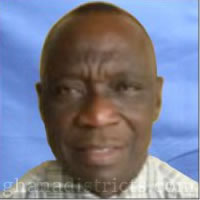Traditional Knowledge
The traditional knowledge of the people in the district is revealed through myths, proverbs, names, sayings, arts, songs, poems and stories.
Myths, Proverbs and Names
Myths are sacred stories of the people which explain the mysteries surrounding their ceremonies, festivals, origin of things like death, creation and historical truths. Proverbs are short witty sayings which express truths and moral lessons. Names are identifiable marks of the people which humanize children. The names have meanings and appellations are attached to particular names.
Sayings and Art
Sayings of the people in the district are expressions or maxims which expose much of traditional knowledge. Experienced old people come out with compositions which give expressions to what are deep within them and actually control their actions. People in the district use artistic symbols to tell a lot about their traditional knowledge. These artistic symbols are silent informants or communicators of the way of life of the people. These artistic symbols include the linguist staff, Akuaba doll and others.
Poems and Stories
During ceremonies, people in the district come out with poems to tell a lot about their traditional knowledge. These poems, for example throw challenge to people to be serious in life. Through stories the people grow in the knowledge of the beliefs of their communities.
Attitude and Practices
Some attitudes and cultural practices in the district include these;
Libation
The people pour libation to the gods during ceremonies to appreciate the good things they have done or to pacify them for the wrong done.
Beliefs in the potency of demons, witches and gods
Majority of the people in the district believe in the potency of demons, witches and gods. This belief helps in social control as the people tend to conform to the norms of society so as to avoid misfortunes or curses from these spirits.
Ancestral Worship
The belief of the people in ancestral worship is based on the fact that the ancestors are in a new world and are closer to God. They believe that the ancestors watch over the lives of the living and are the custodians of majority. They also believe that the ancestors can bless as well as bring calamities, depending on circumstances. Chieftaincy, which portrays much of the cultural heritage of the people hinges on ancestral worship, because the chief is said to serve as a link between society and the ancestors.
Marriage Ceremony
This is performed by the people to bring a man and a woman together as husband and wife. The bridegroom and his family present the bride price to the bride and her family. Marriage provides a socially acceptable means by which young ones are born to replenish the family and society.
Naming Ceremony
The people normally perform naming ceremony on the 8th day after the delivery of the baby in order to welcome the newly born baby into the world. The name identifies the baby and gives him/her a sense of belonging.
Funerals
Funerals are common ceremonies among the people in the district. They are usually organized on Saturdays in connection with the earthly departure of a person as a way of bidding him their farewell.
Moral and Social Values
Moral and Social Values are upheld by the people in the district. These values include godliness, respect, hospitality, service, gratitude, loyalty, tolerance, freedom and responsibilities, truth, integrity, honesty, dedication, patriotism and others.
Good Manners
One gets, particularly the young ones, to know how to conduct oneself as the one learns to greet people, help the aged, go on errands for older people, not being quarrelsome or abusive and appreciating cleanliness. As a result, juvenile immorality is severely punished.
Participation
The people’s participation in all the activities relating to their beliefs and cultural heritage has been on a positive note. Participation in activities like naming, marriage, burial, funerals, festivals and others is considered as a social responsibility that should not be frowned upon.
Positive Cultural Practices Necessary to Promote Development in the District
The district has great cultural and historical heritage in terms of festivals that can be developed for both domestic and international tourism to help promote development.
Prominent tourism among such festivals are the "Papa Nantwi" Festival in Kumawu and the Odwira Festival in Effiduase. During these Festivals people from all walks of life in Ghana and outside the country troop to Kumawu to witness the famous Papa Nantwi Festival.
Ethnic Conflicts and Chieftaincy Disputes likely to hamper development
There have been pockets of chieftaincy disputes at Kumawu and Effiduase. These protracted chieftaincy disputes have hampered development in these two major towns. Currently however, everything seems to be normal.
Implications for development
The people in the district have rich culture that can be tapped to enhance development of the district.
The Traditional Authorities (the chiefs and the elders) should be brought on board in the development agenda of the Assembly
Tourism and Festivals
Tourism is one of the most important sectors of the district’s local economy. However, it has not been developed to a sufficient level, which has impeded a lot of potential investors in this regard. Indeed, considering the major tourist circuits in Ashanti, the district’s potential ranks among the best, yet has, perhaps, the lowest level of actual development.
These undeveloped sites therefore derive potential investors from developing the district’s cultural, historical and ecological heritage, which can be developed for both domestic and international tourism. A major tourist attraction in the district is the Bomfobiri Wildlife Sanctuary which plays host to a wide variety of birds, butterflies, flora and fauna.
The Digya National Park also extends into the district, and here, visitors can find a number of large mammals, while engaging in a Safari-type excursion across the range. Tourists with a love for culture will find this District a fascinating place to visit. There is a shrine at Bodwease, for instance, which dates back to the 18th century.
There is a splendid Kumawu Papa Festival celebrated with pomp and pageantry every year by the people of the district. It is colourful and the festivities themselves make for intriguing watching. Indeed, Sekyere East District is at the heart of Ashanti history and culture, and tourists visiting the district can get a deep insight into the evolution of the famous Ashanti Kingdom, its decline and gradual metamorphosis into the current Ashanti Region, which is the most important part of modern Ghana’s polities.
It offer the modernity derived from being close to the Kumasi metropolis and the access to land and raw materials that are best derived from the rural hinterlands.
During these Festivals people from all walks of life in Ghana and outside the country troop to Kumawu to witness the famous Papa Nantwi Festival.
Date Created : 11/25/2017 2:50:48 AM





 facebook
facebook twitter
twitter Youtube
Youtube TOLL FREE 0800 430 430
TOLL FREE 0800 430 430 +233 593 831 280
+233 593 831 280 GPS: GE-231-4383
GPS: GE-231-4383 info@ghanadistricts.com
info@ghanadistricts.com Box GP1044, Accra, Ghana
Box GP1044, Accra, Ghana